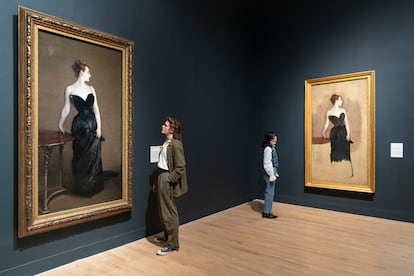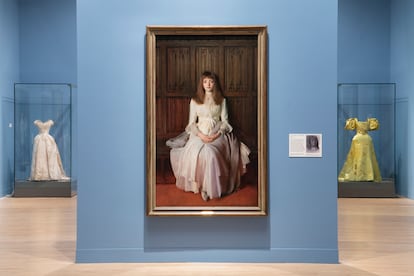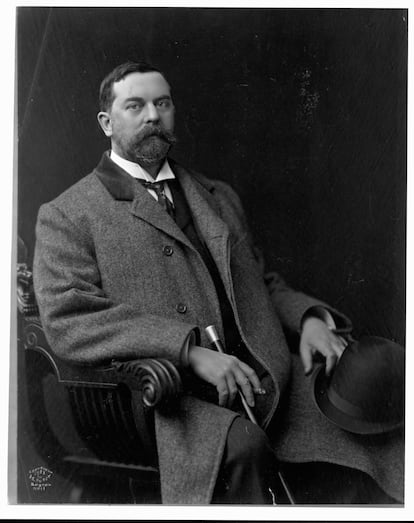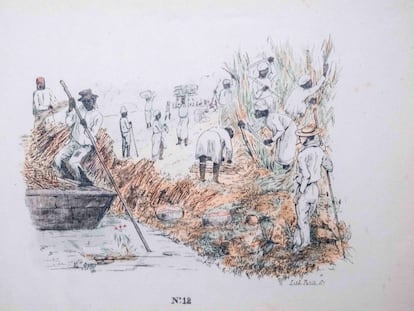When painting becomes haute couture: The work of John Singer Sargent is also a history of fashion
An exhibition at the Tate Britain in London investigates the great American artist’s interest in the attire of his models, with 50 paintings on display along with the dresses that inspired them

He painted aristocrats, industrialists, writers, politicians, and even suffragettes, just as Velázquez and Van Dyck portrayed the royalty of their time. Or perhaps he is more like Frans Hals, the Flemish artist who distanced himself from monarchs to portray a the newly established middle class who ruled during the Baroque period.
In the work of John Singer Sargent (Florence, 1856-London, 1925), the most European of the American painters, there is a collective portrait of Paris and London of the Belle Époque, the two cities where he became one of the most influential people of his time. This was no mean feat in a period with many exuberant characters, the nouveaux riches, unscrupulous careerists ,and ladies forced to change their outfits four times a day to signal their superior social standing.
Sargent was distinguished by his taste for fashion, in which he saw the distinctive sign that allowed him to understand the vicissitudes of the individuals he painted. This is demonstrated by a new exhibition which is one of the highlights of the cultural spring in London. The Tate Britain’s Sargent and Fashion is open to the public until July 7.
The exhibition, which displays around 50 oil paintings along with some of the real dresses that inspired them, reflects the extraordinary attention he paid to his models’ wardrobe. Among them were clients of the haute couture that was then flourishing in the French capital. Firms such as Doucet, Paquin, and especially Worth, which employed 1,200 workers in 1870, supplied silk and velvet garments to young buyers — in many cases American women looking for husbands in Europe. Those dresses were “their social armor,” as Edith Wharton, perhaps the best chronicler of that social stratum, would later write.

When choosing these dresses, their wearers had the garments’ pictorial representation in mind. These women wondered what their reflection would be on the canvas, just as today’s stylists are concerned about how photogenic the dresses they choose for their clients will be. Oil painting was the red carpet of the Belle Époque. Renowned for his impressionistic lines and his attention to attire, Sargent was one of the most sought-after portrait painters of his time. His paintings circulated throughout society and attested to the new power acquired by its stars, like the profiles of the Roman emperors on the coins of antiquity.
“I only paint what I see,” said Sargent. Of course, he was lying. The artist, who charged 1,000 guineas per portrait (about $107,000 in today’s dollars), was known for ignoring the preferences of his models, no matter how much they paid him. He not only acted as a painter, but also as an artistic director. He chose the dresses and accessories, sometimes despite the protests of his clients, imposed the most appropriate decoration, and modeled the fabric on their bodies as a dressmaker would do. Lady Sassoon (1907) is a portrait of Aline de Rothschild, heiress to the banking dynasty, dressed in a black taffeta cape lined with pink satin, a garment full of folds and undulations that seem to look better in the painting than in the museum room, where it seems poorly lit and devoid of magic. Ellen Terry as Lady Macbeth (1889) is another example of Sargent’s power of transformation: a portrait of the famous actress in a jeweled robe, in shades of green and maroon, more spectacular on canvas than in reality, which always seems aa little more prosaic.
Sargent not only acted as a painter, but also as an artistic director: he chose the dresses and accessories, imposed the most appropriate decoration and modeled the fabric on the body as a dressmaker would do.
Each portrait is a small representation, a function on the identity of its sitter, which Sargent stages with relative simplicity, with an elegant economy of resources. The best example could be Portrait of Madame X, one of his most famous works, on loan from the Metropolitan in New York. It is the haughty profile portrait of Virginie Gautreau, born in New Orleans and living in Paris, which caused an immense scandal when it was presented at the Salon in 1884. Her tight black bodice is fastened with two straps full of precious stones. In the original version, the one on the right had slipped from her shoulder, which sparked a controversy that forced Sargent to go into exile in London and repaint the painting with the two straps in place. In 1916, he donated it to the Metropolitan with a message to its director: “I suppose it is the best thing I have ever done.”

In reality, that woman with light-looking skin — a product of makeup, as Sargent demonstrates with malice when contrasting her with a red-hot ear — was descended from slave owners with a large plantation. This is information that is not provided in a show that, at times, feels sumptuous but superficial and deceitful. Some of the dresses and accessories are period pieces, but not all of them. Visitors discover a top hat from 1900 and a French lace collar, devoid of the aura about which Walter Benjamin theorized. They do not match those worn by his models. When a piece of textile does not correspond to the one in the painting, the show falls apart.

The exhibition timidly explores the subversion of gender roles that Sargent practiced, which would have to do “with the deliberate sexual ambiguity and with the homosexual and homosocial circles in which he often moved,” its curators Erica Hirschler and James Finch point out in the exhibition catalog. However, this aspect is not mentioned in the exhibition spaces. And yet it is fundamental to understanding the relationship with the women who posed for him, in whom there is more complicity and fascination than eroticism, or his male portraits, in which it some ambiguity does reside. After all, homoeroticism was one of the motifs of that time, as also demonstrated by the works of Henry James, a close friend of Sargent, or those of E. M. Forster, a great admirer of the painter.
The Tate exhibits androgynous portraits such as that of the languid Albert de Belleroche, a young English painter. There is also the larger-than-life-size canvas of Samuel Pozzi, a French gynecologist wearing a bright scarlet robe de chambre with slippers peeking out from the bottom. The portrait shows Pozzi in an unusual pose for his time that defied the conventional public image of powerful men. But the exhibition does not dare to show Sargent’s secret lithographs, discovered after his death, where he painted naked men barely covered by sheets. Elegance, Balenciaga said, is elimination.
Sign up for our weekly newsletter to get more English-language news coverage from EL PAÍS USA Edition
Tu suscripción se está usando en otro dispositivo
¿Quieres añadir otro usuario a tu suscripción?
Si continúas leyendo en este dispositivo, no se podrá leer en el otro.
FlechaTu suscripción se está usando en otro dispositivo y solo puedes acceder a EL PAÍS desde un dispositivo a la vez.
Si quieres compartir tu cuenta, cambia tu suscripción a la modalidad Premium, así podrás añadir otro usuario. Cada uno accederá con su propia cuenta de email, lo que os permitirá personalizar vuestra experiencia en EL PAÍS.
¿Tienes una suscripción de empresa? Accede aquí para contratar más cuentas.
En el caso de no saber quién está usando tu cuenta, te recomendamos cambiar tu contraseña aquí.
Si decides continuar compartiendo tu cuenta, este mensaje se mostrará en tu dispositivo y en el de la otra persona que está usando tu cuenta de forma indefinida, afectando a tu experiencia de lectura. Puedes consultar aquí los términos y condiciones de la suscripción digital.
More information
Archived In
Últimas noticias
Maduro pleads not guilty before the federal court in New York: ‘I am still the president of Venezuela’
A new test can detect Alzheimer’s from a finger prick
UN team enters Sudanese city of El Fasher after paramilitary massacre: ‘It’s like a ghost town’
A recipe for resistance: Indigenous peoples politicize their struggles from the kitchen
Most viewed
- Gilles Lipovetsky: ‘If you want to live better and fall in love, take Prozac, don’t look to philosophy’
- Alain Aspect, Nobel laureate in physics: ‘Einstein was so smart that he would have had to recognize quantum entanglement’
- Alvin Hellerstein, a 92-year-old judge appointed by Bill Clinton, to preside over Maduro’s trial in New York
- Why oil has been at the center of Venezuela-US conflicts for decades
- Maduro’s downfall puts China’s relationship with Venezuela to the test











































